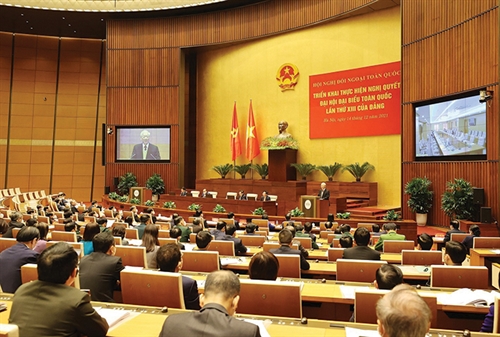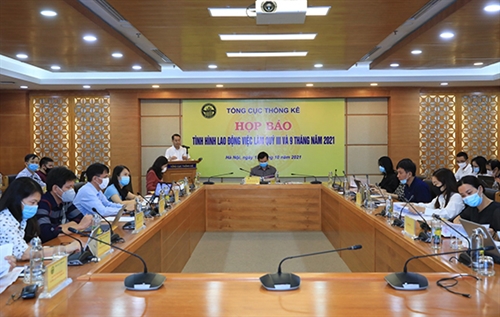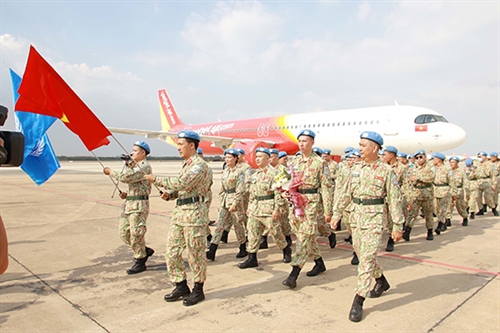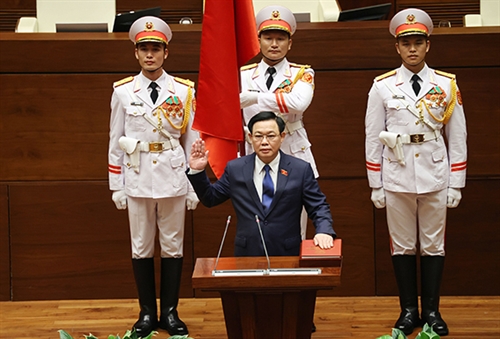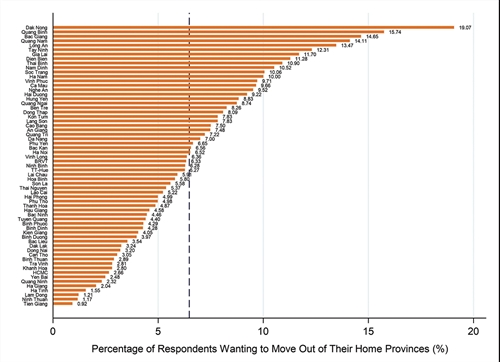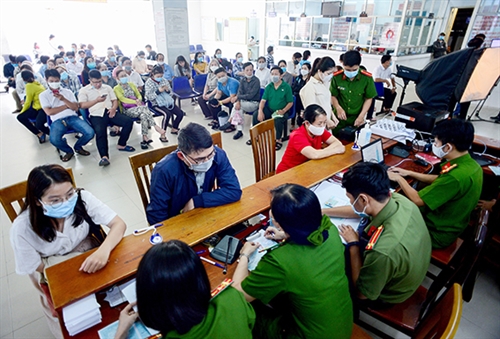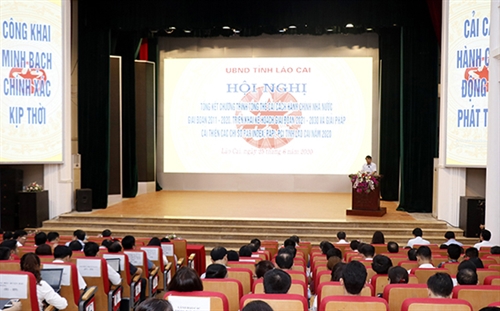Mekong Development Research Institute and United Nations Development Program[1]
Introduction
Vietnam’s responses to contain the SARS-CoV-2 that causes COVID-19 in 2020 was recognized by both citizens and the international development community as swift and effective. Evidence from the decade-long Vietnam Provincial Governance and Public Administration Performance Index (PAPI) with survey findings in 2020 reveals that improved governance and responsiveness of central and local governments contributed to the country’s effective responses to the global COVID-19 pandemic[2]. Demonstrated progresses in the performance in transparency and control of corruption in the public sector might have increased the trust in citizens, who in return might have been willing to comply with extensive contact tracing, quarantine and lockdown measures. Findings from the first-round survey entitled “Citizens’ Opinions of and Experiences with Government Responses to COVID-19 Pandemic in Vietnam” in late 2020 showed high consensus of respondents on and strong support for government policy and actions to contain the pandemic.[3]
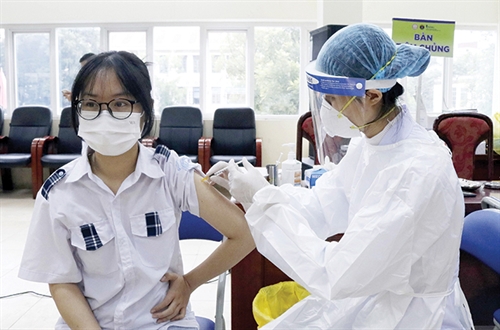 |
| A 12th grader of Bac Giang province is getting a COVID-19 jab__Photo: Dong Thuy/VNA |
However, the arrival of the fourth wave of the COVID-19 pandemic in Vietnam, with the Delta variant encroaching fast across different provinces since May 2021[4], has been very detrimental to the Vietnamese population and the country’s socio-economic development. The country’s economic growth in Quarter 3 of 2021 saw a negative 6.17 percent rate for the first time over two decades of high growth, and by the time this article is written, more than 27,000 lives were claimed just within 2021 due to COVID-19 impact. The low base of COVID-19 vaccination coupled with confusing and fragmented responses at all government levels has made the pandemic’s impact much worse than in 2020.
Therefore, it is important to undertake the second-round study on how the Vietnamese citizens have perceived and experienced the measures to contain the coronavirus adopted by central and local governments from governance and public service provision angles. Citizen views, experiences and expectations have become ever more important because they help inform central and local governments of what have worked and what have not as well as their preference and suggestions moving forward while the pandemic is still around, especially upon the emergence of the fast-spreading Omicron variant in different parts of the world.
To capture how citizens experienced with central and local government responses during the fourth wave of the COVID-19, the second-round phone-based survey was conducted from mid-September to mid-October 2021 - or about two months after major lockdowns in Ho Chi Minh City, Binh Duong, Dong Nai, the Mekong River Delta provinces, and Hanoi, as well as restrictive measures applied by localities with community transmissions in more than 50 provinces. Through this survey, a randomly selected population of 1,501 respondents aged between 18 years and 70 years across all 63 provinces and cities, including 1,142 respondents from Round 1, had their opportunity to reflect on COVID-19 impacts on their well-being, the accessibility and effectiveness of the Government’s relief packages and healthcare, public confidence and trust in the Government’s responses to the pandemic and citizens’ willingness to be vaccinated from May to October 2021. The survey also aimed to suggest policy actions based on citizens’ expectations for central and local governments in response to possible next waves of the COVID-19 pandemic or a similar pandemic.
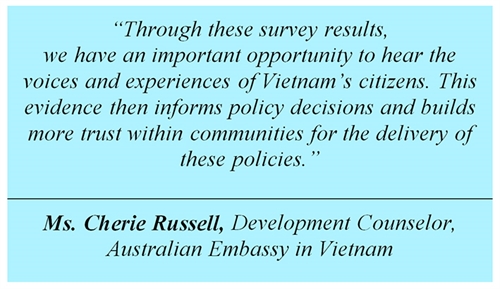 |
This article presents key findings from the second-round survey.[5] It zooms in survey results on questions about three matters: (i) COVID-19 impact on citizens’ well-being, (ii) citizens’ assessment of government responses to the fourth wave of the COVID-19, and (iii) citizens’ preference and expectation. It closes with suggestions for the central and local governments moving forward as the pandemic continues.
COVID-19 impact on citizens’ well-being
The COVID-19 pandemic has caused more severe impact in 2021 than in 2020. As the Round 2 survey findings show, citizens have become even more concerned about the impact of COVID-19 and their well-being has been more severely affected by the pandemic in 2021 compared to 2020. Also, more respondents saw negative and very negative impact of COVID-19 on Vietnam, themselves and their families, and their business in 2021 than in 2020.
As Figure 1 shows, the surveyed respondents across different demographic groups have been most concerned about their children’s education and then about their health. They also feel very worried about their livelihood and business. More than 70 percent of the respondents explicitly expressed such worries. In particular, 68 percent showed great concern about their personal health and 76 percent were worried about their children’s education.
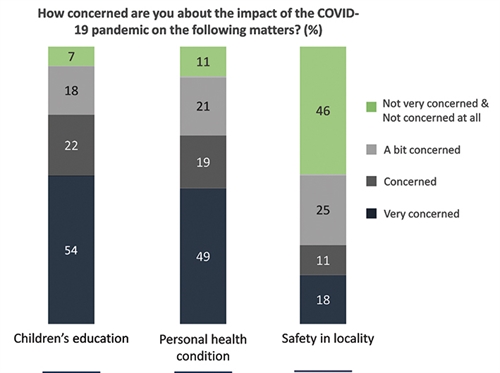 |
| Figure 1: Assessment of COVID-19 impact |
Furthermore, the pandemic has exerted great impact on employment and income in 2021 as in 2020. A large proportion of respondents reported a loss of income, with nearly half saying they lost 51 percent or more of their income, and one in five losing all of their income (see Figure 2). More respondents reported income loss in 2021 than in 2020 (78 percent in 2021 as compared to 65 percent in 2020). Similar to our findings from the first round of the survey in September 2020, those working in the service and agricultural sectors are more prone to job and income loss, along with unskilled workers, non-farm workers and the poor.
The survey also asked the respondents about their alternative sources for living in response to the income loss. Two-thirds of the respondents said they reduced their consumption of nonessentials and essentials while 59 percent reduced their consumption of essential goods. About 35 percent had to use their private savings and 20 percent borrowed from their friends and families to live on. Also, the wealthier tend to count on their private savings and fewer of them had to reduce consumption of goods as compared to the less wealthy.
When asked if they have had to skip meals due to the lack of money during the peak time of the fourth wave of the pandemic from August to October 2021, respondents who are the poor and ethnic minorities, and from the Central Highlands, Southeast and Mekong River Delta regions and heavily hit epicenters and who experienced long-term lockdowns were more impacted.
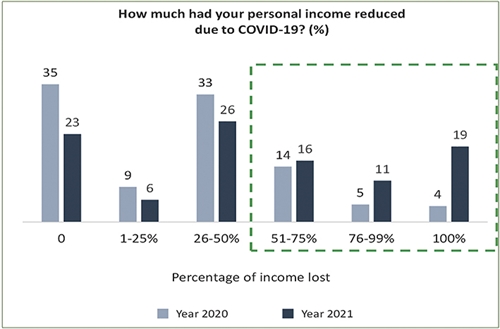 |
| Figure 2: COVID-19 impact on income |
Citizens’ assessment of government responses to COVID-19 Wave 4
Citizens’ assessment of government response showed high but declining positive assessment of government performance in handling the pandemic from 2020. Also, although they were less positive than in 2020, respondents still showed their consensus on and support for government policy and actions to contain the pandemic.
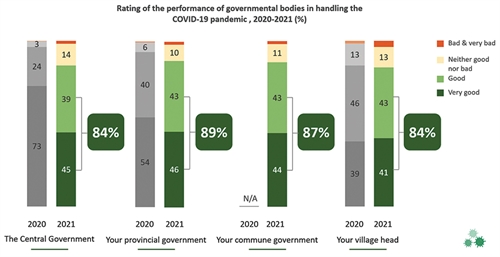 |
| Figure 3: Assessment of COVID-19 response by levels of government |
As Figure 3 shows, fewer said the central government’s response was “very good” in the second-round survey, while commune-level government responses and village heads’ role were more appreciated. If in 2020 survey round, 73 percent would rate the central government’s responses as “very good”, the proportion dropped to 45 percent in 2021 survey round. Overall, 84 percent of the respondents rating the responses from the central government as “good” or “very good” (compared to 97 percent in 2020), 89 percent rating the response from their provincial governments as “good” or “very good” (94 percent in 2020). However, such positive responses varied across provinces in the second round. In the heavily hit epicenters including Ho Chi Minh City, Binh Duong, Dong Nai and Long An provinces (abbreviated to HCMC, BD, DN and LA in the figures below), there was less positive feedback than in other provinces, with the proportions of respondents giving positive feedback ranging from 70 percent for village heads to 74 percent for the central government[6].
It is noteworthy that, although facing job and income losses, citizens showed strong support for strict containment measures. A significant majority (78 percent) expressed their strong support for strict measures like full lockdowns and curfews that were applied in heavily hit epicenters[7]. All respondents supported mask mandates, while fewer would support closure of wet markets or schools. Although a majority of the respondents said that provincial government responses were timely, 19 percent, especially those living in epicenters, said that actions by their province or city in response to COVID-19 were too abrupt leaving little time to adjust (see Figure 4).
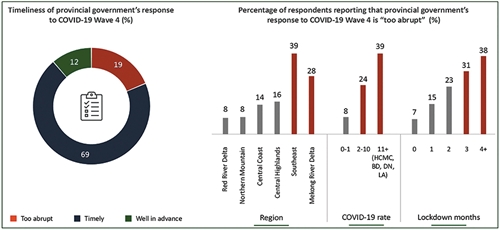 |
| Figure 4: Timeliness in provincial governments’ responses to COVID-19 Wave 4 |
On the publicity and accessibility of the Government’s VND 26 trillion aid package, the survey findings showed that the proportion of people receiving the aid package was low. About 70 percent of the respondents were aware of the package, while last year, 87 percent had heard about the Government’s VND 62 trillion package. However, ethnic minorities, women, poorer and rural respondents were less likely to be aware of the package, which is concerning.
 |
| Figure 5: Targets of Government’s VND 26 trillion aid package, 2021 |
With respect to accessibility, only 13 percent reported having received support from the 2021’s VND 21 trillion aid package (which was approved on July 1, 2021). This proportion was lower than that of respondents saying that they had access to the 2020’s VND 61 trillion package (21 percent). As shown in Figure 5, the percentage of rural respondents receiving the aid package was only half that of urban respondents. Many poor, farming, self-employed respondents said they had not received support. Also, respondents’ assessment of the procedure to access the government aid package this year was less positive than in 2020, with only 46 percent agreeing that the procedure was simple. Those who did receive the support said that the amount was delivered as informed and in a timely way.
More importantly, during the fourth wave of the pandemic, the Government has not been the only source of support for those in need. As this year’s survey finds, support from non-governmental organizations (NGOs), social organizations, charity foundations, and individual donations was remarkable for those who did not have access to the official aid package. About 25 percent of the respondents who did not get access to the VND 26 trillion package said they got support from NGOs, charity groups and individual donations. Also, about 13 percent got in-kind support from governments.
The survey also asked about how strict measures like full lockdowns affected citizens’ access to food, necessary goods and public services (including administrative and healthcare services). It finds that about one-third of the respondents said they could not get access to food and 21 percent said they could not get access to necessary goods. More of those who are the poor, live in the Southeast and Mekong River Delta regions and heavily hit epicenters, and experienced long-term lockdowns faced problems with accessing food. The same trend is for accessing necessary goods, but not as high as for accessing food.
 |
| Figure 6: Other sources of support during the fourth wave of the pandemic |
In the meantime, electronic public administrative services were not yet utilized during the fourth wave of the pandemic. Among 23 percent that reported using public administrative services from May to October 2021, only 3 percent did the services online while 66 percent still went to commune one-stop shops and 17 percent used district one-stop shops. The use of public administrative services was much less common in epicenters and in places with long-term lockdowns.
Regarding access to healthcare facilities during the fourth wave of the pandemic, one-third of the total number of respondents said they used healthcare services, and 80 percent of the users went to public hospitals or clinics. Many (40 percent) had to submit COVID-19 test results to be admitted to healthcare facilities while 7 percent had to apply for travel permits from commune governments before they can go to hospitals. Among those who had a disease to get cured, 5 percent blamed strict travel restrictions that prevented them from going to hospitals.
 |
| Figure 7: Lockdown impact on access to food and necessary goods |
Citizens’ preference and expectation
The survey also reflects citizens’ preference and expectation of how central and local governments should respond to the pandemic. It also asked if respondents support migrants in COVID-19 heavily hit provinces to return to their localities from where migrants leave temporarily.
As shown in Figure 8, despite significant socio-economic impact of the fourth wave of the pandemic, most respondents clearly prioritized health over economy. As many as 83 percent of the respondents agreed that “The government’s highest priority should be saving as many lives as possible, even if it means the economy will sustain more damage and recover slowly”. Fewer poor and fewer respondents from the heavily hit epicenters would have the same preference.
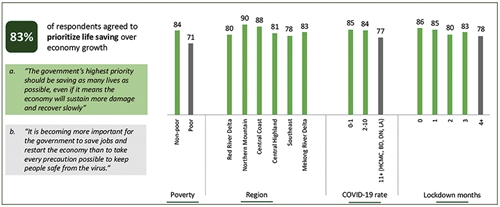 |
| Figure 8: Share of respondents who opted for saving lives over economy growth (%) |
When asked at which scale full and strict lockdowns should be implemented, a majority of respondents (59 percent) preferred lockdowns to be constrained to communities with COVID-19 cases. Barely 1 percent said lockdowns should not be applied anymore, while 7 percent still opted for a national lockdown.
When the phone-based survey was carried out, there were waves of migrants fleeing their receiving provinces, especially from Ho Chi Minh City, Dong Nai, Binh Duong and Long An, to return home. By mid-October 2021, it was reported that 1.5 million temporary migrants left the epicenters. The survey asked the whole population of 1,501 respondents, who were selected as those with permanent residency status on purpose, if they would support migrants returning to their home provinces even when the returners would be their neighbors. Overall, 57 percent of respondents supported migrants from epicenters to go back to their home provinces. Younger respondents were more supportive, so were female respondents and those with post-secondary education levels. Nonetheless, less support was from respondents from the Red River delta and Northern mountain provinces, or provinces with fewer cases and without lockdowns.
 |
Suggestions moving forward
The data collected have been useful to understand how the the first wave of the pandemic has affected citizens’ well-being, public trust in government responses to the pandemic, the accessibility to the Government’s aid package, and the use and accessibility of basic services in provinces. The survey also provides important insights into citizens’ preference and suggestions for the Government to address the pandemic and its severe impact as the COVID-19 situation continues to evolve with the emergence of new variants - notably Omicron.
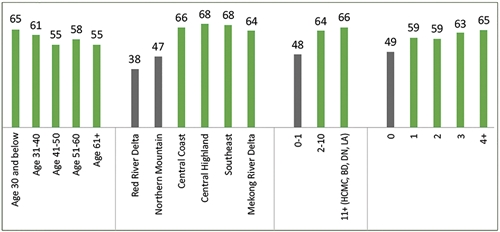 |
| Figure 9: Share of respondents who supported migrants to travel back to their hometown (%) |
Ultimately, the survey results help inform central and local governments of how to better respond to the ongoing and future pandemics. Below are suggestions for Vietnam moving forward:
- Citizens’ feedback and preferences on crisis responses are important for the Government to review solutions moving forward.
- Aid packages should target the poor, the unskilled and seasonal laborers, those working in the service and tourism sectors.
- Community-based support and support from NGOs, social organizations and charity groups and individuals and during the pandemic and similar crises should be appreciated and recognized formally. Simplification of administrative procedures for cash aid packages will make the aid timelier accessed.
- E-public services should be reassessed and upgraded to be more user-friendly for higher utility of contactless means to interact with the Government.
- As the trust in public health facilities remains high, public investment in grassroots-level health facilities should be increased to reduce heavy loads on central- and provincial-level hospitals, especially during pandemics like COVID-19.-
